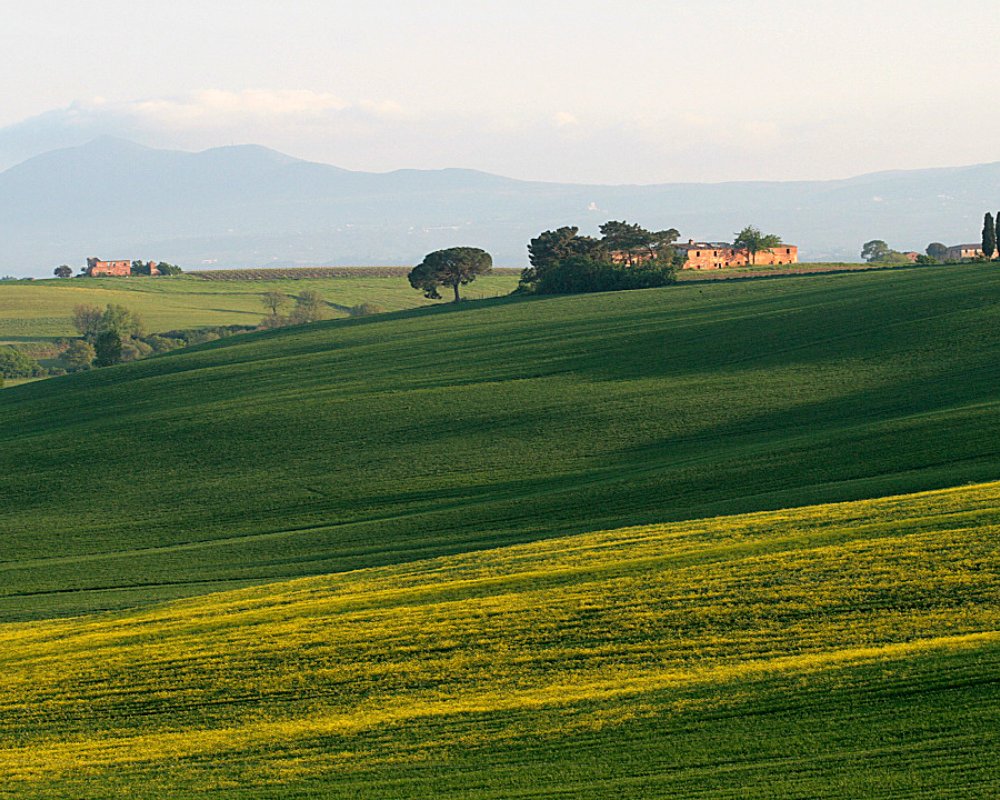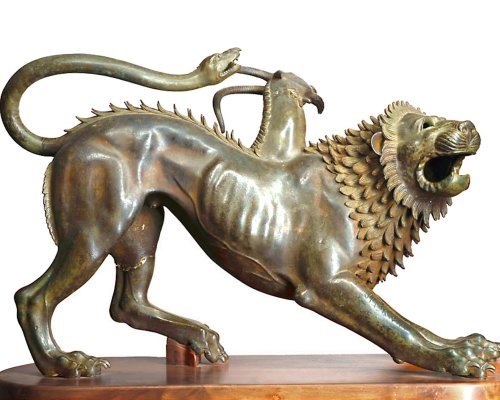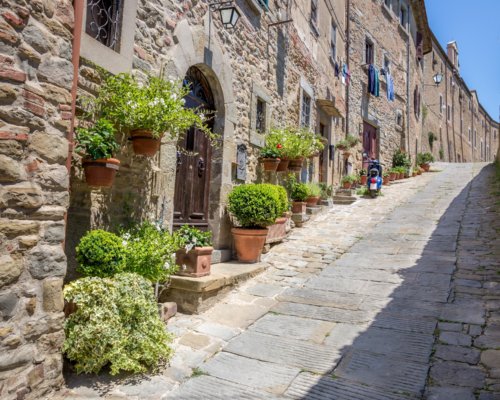


Eine Reise zu den wichtigsten etruskischen Städten im Gebiet von Arezzo. Erfahren Sie mehr über die Geschichte dieser Zivilisation
Im Gebiet von Arezzo wurde der Großteil der etruskischen Artefakte entdeckt. Diese Route katapultiert uns in die Vergangenheit zurück und wir können die Bräuche einer Zivilisation entdecken, die noch heute ein Rätsel aufgibt. Zwei Täler im Gebiet von Arezzo bewahren viele Zeugnisse, das Valdichiana und das Casentino, die beide aufgrund ihrer geografischen Lage von den Etruskern ausgewählt wurden, ersteres verengt sich in Richtung Chiusi, letzteres erweitert sich nach Norden hinter dem Apennin.
Wir beginnen unsere Reise in Arezzo, einer der wichtigsten etruskischen Städte, die sehr wahrscheinlich die Stätte eines der 12 „lucumos“ oder Herrscher war. Herausragende Kunstwerke aus der Zeit, darunter die Chimäre, die derzeit im Museo Archeologico di Firenze aufbewahrt wird, und die große Nekropole Poggio del Sole, die im 6. Jahrhundert v. Chr. errichtet und bis zur Zeit der Römer genutzt wurde. Das Museo Archeologico Nazionale Gaio Cilnio Mecenate, das innerhalb des Klosters San Bernardino liegt, bewahrt archäologische Schätze, die die Bedeutung von Arezzo und seiner Umgebung zur Zeit der Etrusker anschaulich belegen.
Wir beginnen unsere Reise in Arezzo, einer der wichtigsten etruskischen Städte, die sehr wahrscheinlich die Stätte eines der 12 „lucumos“ oder Herrscher war. Herausragende Kunstwerke aus der Zeit, darunter die Chimäre, die derzeit im Museo Archeologico di Firenze aufbewahrt wird, und die große Nekropole Poggio del Sole, die im 6. Jahrhundert v. Chr. errichtet und bis zur Zeit der Römer genutzt wurde. Das Museo Archeologico Nazionale Gaio Cilnio Mecenate, das innerhalb des Klosters San Bernardino liegt, bewahrt archäologische Schätze, die die Bedeutung von Arezzo und seiner Umgebung zur Zeit der Etrusker anschaulich belegen.
Nach Arezzo begeben wir uns nach Cortona, eine bedeutende etruskische Festung im 8. und 7. Jahrhundert v. Chr. Etrusker errichteten im 4. Jahrhundert v. Chr. die imposante Mauer, die die Stadt 3 Kilometer lang umfasste, die Adelsgräber in der Umgebung und den monumentalen Grabaltar mit Sphinxen, den einzigen seiner Art in Italien. Cortona beherbergt auch die Tabula Cortonensis, eine Bronzetafel mit einer der längsten Inschriften in etruskischer Sprache. Seit 1728 ist der Palazzo Pretorio Sitz der Etruskischen Akademie mit dem MAEC (Museo dell'Accademia Etrusca e della Città di Cortona), das eine umfangreiche Sammlung von alten Artefakten ausstellt.
Nach Arezzo begeben wir uns nach Cortona, eine bedeutende etruskische Festung im 8. und 7. Jahrhundert v. Chr. Etrusker errichteten im 4. Jahrhundert v. Chr. die imposante Mauer, die die Stadt 3 Kilometer lang umfasste, die Adelsgräber in der Umgebung und den monumentalen Grabaltar mit Sphinxen, den einzigen seiner Art in Italien. Cortona beherbergt auch die Tabula Cortonensis, eine Bronzetafel mit einer der längsten Inschriften in etruskischer Sprache. Seit 1728 ist der Palazzo Pretorio Sitz der Etruskischen Akademie mit dem MAEC (Museo dell'Accademia Etrusca e della Città di Cortona), das eine umfangreiche Sammlung von alten Artefakten ausstellt.
Heading further south, we come to Chianciano Terme, whose waters and their beneficial properties have been utilized since the Etruscan and Roman eras, when both civilizations settled I the area and built important town centres. The Etruscan Museum in the city conserves important artefacts from the area related to burial traditions: canopic jars, ceramics, grave goods and the ruins of a terracotta pediment from the Temple of Fucoli depicting mythological scenes. The museum has two particularly important sections, one dedicated to the “Etruscan woman” and the other to the “Etruscan banquet”.
Heading further south, we come to Chianciano Terme, whose waters and their beneficial properties have been utilized since the Etruscan and Roman eras, when both civilizations settled I the area and built important town centres. The Etruscan Museum in the city conserves important artefacts from the area related to burial traditions: canopic jars, ceramics, grave goods and the ruins of a terracotta pediment from the Temple of Fucoli depicting mythological scenes. The museum has two particularly important sections, one dedicated to the “Etruscan woman” and the other to the “Etruscan banquet”.
Not far from Chianciano, we find another city with ancient origins. Traces of the area’s Etruscan past can be found around Sarteano, dating to the 9th to 1st centuries BCE. The most important necropolises from this period are Palazzina, located along one of the vie Cupe, the name for the routes leading to Chiusi, and Pianacce. The latter has conserved a series of extraordinary discoveries and is located in a stunning corner of nature, boasting a splendid view of the Valdichiana. Here, you can visit the exceptional Quadriga Infernale tomb, vaunting unique paintings and bright colours dating to the second half of the 4th century BCE that depict a red-haired demon leading a chariot pulled by two lions and two griffins, probably Charun – the Etruscan Charon – in his only depiction as Auriga guiding souls to Hades. Alongside the Quadriga Infernale tomb, you can find numerous hypogea dated to between the end of the 6th century to the 1st century BCE; these comprise a necropolis occupied by noble families of a certain rank. The demi-circular podium-altartied to three of these hypogea and dedicated to funerary rituals is of great interest. This extraordinary site, which is open to the public, is only one of the several tombs in the area. Traces of this intense and dynamic past, including Orientalized canopic jars, bucchero, Etruscan and Attic ceramics, extraordinary funerary statues made from pietra fetida and Roman artefacts, can be found on display at the Archeological Museum in Sarteano.
Not far from Chianciano, we find another city with ancient origins. Traces of the area’s Etruscan past can be found around Sarteano, dating to the 9th to 1st centuries BCE. The most important necropolises from this period are Palazzina, located along one of the vie Cupe, the name for the routes leading to Chiusi, and Pianacce. The latter has conserved a series of extraordinary discoveries and is located in a stunning corner of nature, boasting a splendid view of the Valdichiana. Here, you can visit the exceptional Quadriga Infernale tomb, vaunting unique paintings and bright colours dating to the second half of the 4th century BCE that depict a red-haired demon leading a chariot pulled by two lions and two griffins, probably Charun – the Etruscan Charon – in his only depiction as Auriga guiding souls to Hades. Alongside the Quadriga Infernale tomb, you can find numerous hypogea dated to between the end of the 6th century to the 1st century BCE; these comprise a necropolis occupied by noble families of a certain rank. The demi-circular podium-altartied to three of these hypogea and dedicated to funerary rituals is of great interest. This extraordinary site, which is open to the public, is only one of the several tombs in the area. Traces of this intense and dynamic past, including Orientalized canopic jars, bucchero, Etruscan and Attic ceramics, extraordinary funerary statues made from pietra fetida and Roman artefacts, can be found on display at the Archeological Museum in Sarteano.
The museum organizes visits to the Etruscan tombs near Lake Chiusi: Leone, with engraved coffer ceilings and part of the original pictorial decorations; Pellegrina, which belonged to the Sentinates family (open every day); and the famous Scimmia, uncovered in 1846 by A. François. A visit to the Labyrinth of Porsenna is also highly recommended, a fascinating underground route that winds through an Etruscan aqueduct.
Nach den historischen lateinischen Quellen ist Chiusi, das nur wenige Kilometer von Sarteano und Chianciano entfernt liegt, eine der ältesten etruskischen Städte. Der Wohlstand von Chiusi (Clevsin auf Etruskisch) ist eng mit dem fruchtbaren Boden und seiner strategischen Lage enlang einer wichtigen Handelsstraße verbunden. In dem Museo archeologico nazionale werden vorwiegend etruskische Artefekate nach Chronologie und Themenbereichen ausgestellt, sodass die Besucher ihren ursprünglichen Kontext rekonstruieren können. Einige der Exponate wurden vor Ort gefertigt (Gesichtsurnen, Bucchero und Grabskulpturen aus pietra fetida oder Terrakotta), während die Keramikarbeiten aus Attika stammen (zusammen mit etruskischen Kopien). Das Museum beherbergt auch römische Artefakte und lombardische Objekte.
Das Museum organisiert Führungen zu den etruskischen Gräbern unweit des Chiusi-Sees: Leone, with engraved coffer ceilings and part of the original pictorial decorations; Pellegrina, which belonged to the Sentinates family (open every day); and the famous Scimmia, uncovered in 1846 by A. François. A visit to the Labyrinth of Porsenna is also highly recommended, a fascinating underground route that winds through an Etruscan aqueduct
The museum organizes visits to the Etruscan tombs near Lake Chiusi: Leone, with engraved coffer ceilings and part of the original pictorial decorations; Pellegrina, which belonged to the Sentinates family (open every day); and the famous Scimmia, uncovered in 1846 by A. François. A visit to the Labyrinth of Porsenna is also highly recommended, a fascinating underground route that winds through an Etruscan aqueduct.
Nach den historischen lateinischen Quellen ist Chiusi, das nur wenige Kilometer von Sarteano und Chianciano entfernt liegt, eine der ältesten etruskischen Städte. Der Wohlstand von Chiusi (Clevsin auf Etruskisch) ist eng mit dem fruchtbaren Boden und seiner strategischen Lage enlang einer wichtigen Handelsstraße verbunden. In dem Museo archeologico nazionale werden vorwiegend etruskische Artefekate nach Chronologie und Themenbereichen ausgestellt, sodass die Besucher ihren ursprünglichen Kontext rekonstruieren können. Einige der Exponate wurden vor Ort gefertigt (Gesichtsurnen, Bucchero und Grabskulpturen aus pietra fetida oder Terrakotta), während die Keramikarbeiten aus Attika stammen (zusammen mit etruskischen Kopien). Das Museum beherbergt auch römische Artefakte und lombardische Objekte.
Das Museum organisiert Führungen zu den etruskischen Gräbern unweit des Chiusi-Sees: Leone, with engraved coffer ceilings and part of the original pictorial decorations; Pellegrina, which belonged to the Sentinates family (open every day); and the famous Scimmia, uncovered in 1846 by A. François. A visit to the Labyrinth of Porsenna is also highly recommended, a fascinating underground route that winds through an Etruscan aqueduct